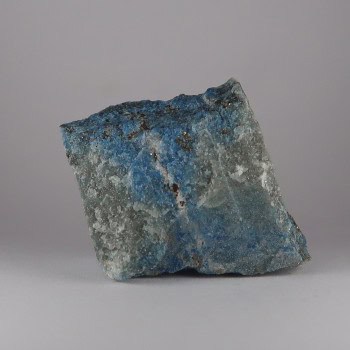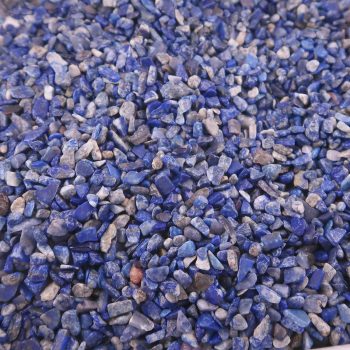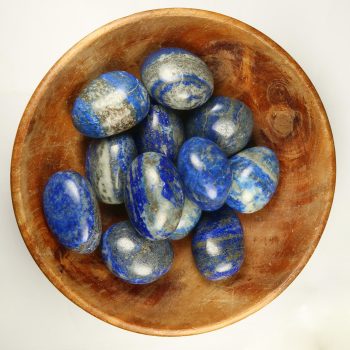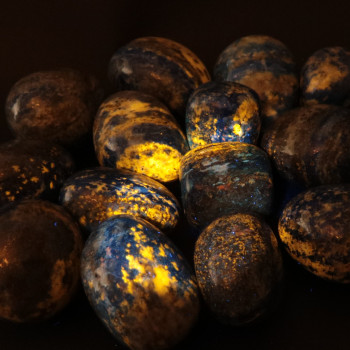Lapis Lazuli
Lapis Lazuli is a blue rock, usually comprised of the minerals Lazurite, Pyrite, Sodalite and Calcite.
It often has some grey or white Calcite streaks or patches, and may have more or less Pyrite, depending on the locale and the quality. Some people like the purer blue material, I personally prefer pieces with more colours.
Lapis has been used as a decorative material since antiquity, and the majority is still mined in the same location – around the foothills of the Himalayas, in modern day Afghanistan/Pakistan.
It is usually sold polished, as the blue and gold stand out very nicely, giving the stone an almost regal look – perhaps why I associate it so much with the pharaohs of ancient Egypt, who loved blue and gold colours and did use Lapis Lazuli decoratively.
It was also used in Medieval Europe, to form an extremely expensive luxury pigment known as ‘Ultramarine’, which was almost exclusively used by the richest of the rich – primarily churches. It was generally the colour associated with Mary in the Christian faith.
Showing all 5 results
-

Lapis Lazuli from the Cazadero river, Chile
Price range: £6.50 through £12.50 -

Lapis Lazuli Specimens (UV Reactive)
Price range: £10.00 through £12.00 -

Lapis Lazuli tumblechips
£2.00 -

Lapis Lazuli Tumblestones
-

Lapis Lazuli tumblestones (Fluorescent)
Price range: £3.00 through £6.50
Appearance
Lapis often has some grey or white Calcite streaks or patches, and may have more or less Pyrite, depending on the locale and the quality. Some people like the purer blue material, I personally prefer pieces with more colours.
Uses and History
Lapis Lazuli has been used for various things since antiquity – usually as a decorative object.
There are beads and carvings from 3000 BCE all around Afghanistan and the Middle East.
Ancient Egyptians carved scarabs from Lapis – Cleopatra used eyeshadow made from its powder.
During the Middle Ages and the Renaissance, Lapis was ground into a pigment called Ultramarine, used for the finest paintings. It was one of the most expensive pigments, and generally reserved for paintings of the Virgin Mary.
There are numerous famous paintings which use Ultramarine as a pigment, including Vermeer’s “The Girl with a Pearl Earring”, and Van Gogh’s “The Starry Night”.
There are many references to Sapphire in the Old Testament, but scholars believe these are references to Lapis Lazuli, rather than Corundum. It may have been referred to as Sapphire even until the Middle Ages.
Locales
Asia:
- Badakhshan, Afghanistan
- Gorno-Badakhshan, Tajikistan
- Lake Baikal, Russia
- Mandalay Region, Myanmar
- Pamir Mountains, Tajikistan
Europe:
- Lazio, Italy
South America:
- Coquimbo, Chile
North America:
- San Bernadino County, California, USA
- Gunnison County, Colorado, USA
Mineralogy
Lapis Lazuli specimens are generally comprised of Lazurite, Calcite, Sodalite and Pyrite.
Some specimens also contain Augite, Diopside, Enstatite, Mica, Hauynite/Hauyne, Hornblende, Nosean, and Loellingite.
By its nature, Lapis has a fairly variable hardness, depending on the composition of the stone.
Depending on where the stone is tested, the hardness can be between 3 and 5.5 – the Calcite will be softer than the Lazurite or Pyrite!
The specific gravity of Lapis is again fairly variable, as it is made up of several different minerals.
A piece with a significant amount of Calcite will have a different specific gravity to a piece with more Lazurite. Typically it is between 2.7 and 2.9.
Hazards and Warnings
Lapis Lazuli contains Pyrite, which is Iron Sulfide. You may find many references online to Pyrite leaching sulphuric acid – this is not true.
However, “pyrite decay” is a well known mineralogical issue, which causes the specimen to decay as it reacts with water and oxygen and converts to Iron Sulfate.
This is not a hazard, but can cause damage to specimens over time. However – this is more prone to happening in specimens with larger amounts of Pyrite – particularly fossilised Ammonites.
As long as the specimen is stored in an area with a relative humidity of under 60% it should be fine – if in a cabinet or case, store with some silica gel or similar.
Almost all rocks, minerals (and, frankly, almost all other substances on earth) can produce toxic dust when cutting, which can cause serious respiratory conditions including silicosis.
When cutting or polishing rocks, minerals, shells, etc, all work should be done wet to minimise the dust, and a suitable respirator or extraction system should be used.
